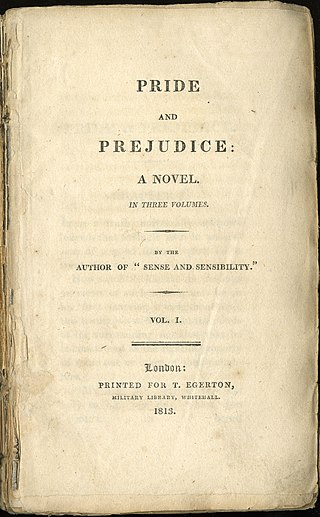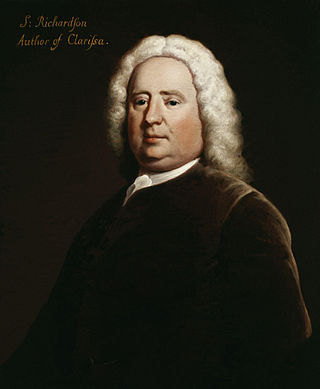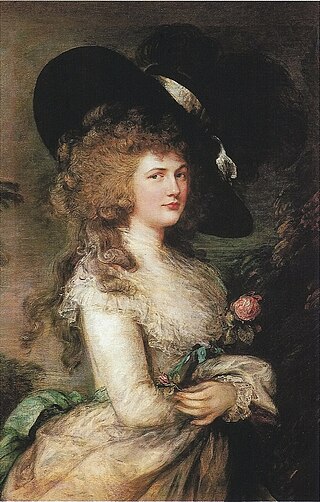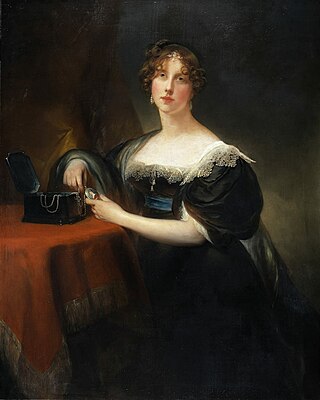Related Research Articles

An epistolary novel is a novel written as a series of letters between the fictional characters of a narrative. The term is often extended to cover novels that intersperse documents of other kinds with the letters, most commonly diary entries and newspaper clippings, and sometimes considered to include novels composed of documents even if they do not include letters at all. More recently, epistolaries may include electronic documents such as recordings and radio, blog posts, and e-mails. The word epistolary is derived from Latin from the Greek word ἐπιστολή, epistolē, meaning a letter . This type of fiction is also sometimes known by the German term Briefroman or more generally as epistolary fiction.

Pride and Prejudice is an 1813 novel of manners by English author Jane Austen. The novel follows the character development of Elizabeth Bennet, the protagonist of the book, who learns about the repercussions of hasty judgments and comes to appreciate the difference between superficial goodness and actual goodness.

Sense and Sensibility is the first novel by the English author Jane Austen, published in 1811. It was published anonymously; By A Lady appears on the title page where the author's name might have been. It tells the story of the Dashwood sisters, Elinor and Marianne as they come of age. They have an older half-brother, John, and a younger sister, Margaret.

Samuel Richardson was an English writer and printer known for three epistolary novels: Pamela; or, Virtue Rewarded (1740), Clarissa: Or the History of a Young Lady (1748) and The History of Sir Charles Grandison (1753). He printed almost 500 works, including journals and magazines, working periodically with the London bookseller Andrew Millar. Richardson had been apprenticed to a printer, whose daughter he eventually married. He lost her along with their six children, but remarried and had six more children, of whom four daughters reached adulthood, leaving no male heirs to continue the print shop. As it ran down, he wrote his first novel at the age of 51 and joined the admired writers of his day. Leading acquaintances included Samuel Johnson and Sarah Fielding, the physician and Behmenist George Cheyne, and the theologian and writer William Law, whose books he printed. At Law's request, Richardson printed some poems by John Byrom. In literature, he rivalled Henry Fielding; the two responded to each other's literary styles.

Georgiana Cavendish, Duchess of Devonshire, was an English aristocrat, socialite, political organiser, author, and activist. Born into the Spencer family, married into the Cavendish family, she was the first wife of William Cavendish, 5th Duke of Devonshire, and the mother of the 6th Duke of Devonshire.
This article contains information about the literary events and publications of 1771.

Augustus Henry FitzRoy, 3rd Duke of Grafton,, styled Earl of Euston between 1747 and 1757, was a British Whig statesman of the Georgian era. He is one of a handful of dukes who have served as prime minister.

John Fane, 10th Earl of Westmorland,, styled Lord Burghersh between 1771 and 1774, was a British Tory politician of the late 18th and early 19th centuries, who served in most of the cabinets of the period, primarily as Lord Privy Seal.

Clarissa; or, The History of a Young Lady: Comprehending the Most Important Concerns of Private Life. And Particularly Shewing, the Distresses that May Attend the Misconduct Both of Parents and Children, In Relation to Marriage is an epistolary novel by English writer Samuel Richardson, published in 1748. It tells the tragic story of a young woman, Clarissa Harlowe, whose quest for virtue is continually thwarted by her family. The Harlowes are a recently wealthy family whose preoccupation with increasing their standing in society leads to obsessive control of their daughter, Clarissa. It is considered one of the longest novels in the English language. It is generally regarded as Richardson's masterpiece.

George Henry FitzRoy, 4th Duke of Grafton, KG, styled Earl of Euston until 1811, was a British peer and Whig politician who sat in the House of Commons from 1782 to 1811 when he succeeded to the Dukedom.

The History of Sir Charles Grandison, commonly called Sir Charles Grandison, is an epistolary novel by English writer Samuel Richardson first published in February 1753. The book was a response to Henry Fielding's The History of Tom Jones, a Foundling, which parodied the morals presented in Richardson's previous novels. The novel follows the story of Harriet Byron who is pursued by Sir Hargrave Pollexfen. After she rejects Pollexfen, he kidnaps her, and she is only freed when Sir Charles Grandison comes to her rescue. After his appearance, the novel focuses on his history and life, and he becomes its central figure.
The sentimental novel or the novel of sensibility is an 18th-century literary genre which celebrates the emotional and intellectual concepts of sentiment, sentimentalism, and sensibility. Sentimentalism, which is to be distinguished from sensibility, was a fashion in both poetry and prose fiction beginning in the eighteenth century in reaction to the rationalism of the Augustan Age.
Love and Freindship [sic] is a juvenile story by Jane Austen, dated 1790. While aged 11–18, Austen wrote her tales in three notebooks. These still exist, one in the Bodleian Library and the other two in the British Museum. They contain, among other works, Love and Friendship, written when she was 14, and The History of England, written at 15.

The Duchess is a 2008 historical drama film directed by Saul Dibb, who co-wrote the screenplay with Jeffrey Hatcher and Anders Thomas Jensen, based on the 1998 book Georgiana, Duchess of Devonshire by Amanda Foreman, about the late 18th-century English aristocrat Georgiana Cavendish, Duchess of Devonshire. She was an ancestor of Diana, Princess of Wales, where the quote "There were three people in her marriage" in the promotional poster comes from.
Sophia, Lady Burrell (1753–1802) was an English poet and dramatist.

Lady Catherine de Bourgh is a character in the 1813 novel Pride and Prejudice by Jane Austen. According to Janet Todd, Lady Catherine can be seen as a foil to the novel's protagonist Elizabeth Bennet.
Francis Hare-Naylor (1753–1815) was an English historian, novelist and playwright. He eloped with the painter Georgiana Hare-Naylor and they had most of their children abroad. They returned to Herstmonceux when his father died. Georgiana died in Lausanne and Hare-Naylor sold Herstmonceux and never returned.

Georgiana Dorothy Howard, Countess of Carlisle was a British noblewoman. She was born after nine years of childless marriage between William Cavendish, 5th Duke of Devonshire, and his wife, Lady Georgiana Spencer, the political hostess and socialite. As such, she was a member of one of the country's grandest and richest families.
The Sylph is a 1778 novel by Georgiana Cavendish, Duchess of Devonshire. It was her second printed work and was published anonymously under the name 'A Young Lady'.
References
- ↑ "Public Record Office". Find My Past. Retrieved 30 November 2021.
- ↑ "LONDON GAZETTE: Royal Exchange Assurance Office". Find My Past. London Gazette. Retrieved 30 November 2021.
- ↑ Samuel Richardson's tragic novel Clarissa had appeared in 1748.
- ↑ The Gentleman's Magazine. A. Dodd and A. Smith. 1824. pp. 136–. Retrieved 28 April 2013.
- ↑ A Literary History of Women's Writing in Britain, 1660-1789. Cambridge University Press. 7 September 2006. pp. 335–. ISBN 978-1-139-45858-0 . Retrieved 28 April 2013.
- ↑ The translation was by Johann Friedrich Junius. Nuremberg City Library (in German): Retrieved 5 October 2014.
- ↑ Ruth Perry: Novel Relations. The Transformation of Kinship in English Literature, 1748–1818 (Cambridge, UK: Cambridge University Press, 2004), p. 150n.
- ↑ No. 45 [1771], p. 74. Reported in Blackwell Reference Online Retrieved 5 October 2014.
- ↑ Perry..., pp. 150 and 397. The sudden instinctive discovery of a near relative as a plot device is parodied in Jane Austen's Love and Freindship (1790), quoted by Perry (p. 400).
- ↑ Blackwells...; Li-Ping Geng's review in Eighteenth Century Fiction, Vol. 15 (2003), No. 2. Retrieved 9 October 2014.
- ↑ Georgiana Duchess of Devonshire (1779). The Sylph. Northwestern University Press. pp. 11–. ISBN 978-0-8101-2229-1 . Retrieved 28 April 2013.
- ↑ Gothic Wanderer blog (by the American critic Tyler R. Tichelaar) provides a synopsis and analysis. Retrieved 5 October 2014.
- ↑ Sophia Briscoe to W. Pitt, 14 December 1797. Chatham Papers, British National Archives, Vol. 264, f. 168. Quoted in Dror Wahrman: Imagining the Middle Class... (Cambridge, UK: Cambridge University Press, 1995).